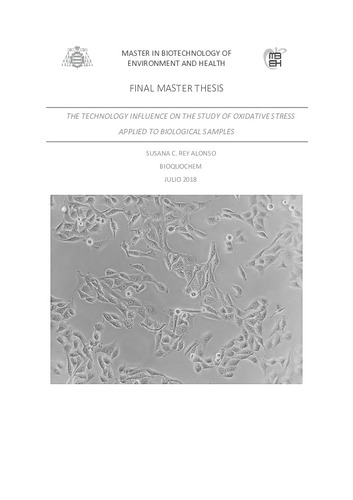The technology influence on the study of oxidative stress applied to biological samples
Autor(es) y otros:
Director(es):
Palabra(s) clave:
Estrés oxidativo
Antioxidante
Técnicas
Cáncer de próstata
Fecha de publicación:
Serie:
Máster Universitario en Biotecnología del Medio Ambiente y la Salud
Descripción física:
Resumen:
Oxidative stress has been described as an imbalance between free radicals and antioxidants that is present in many diseases as cancer, among others. The increase on highly reactive species as oxygen derived species, cause damage to many biomolecules as DNA, lipids and proteins, with harmful consequences. This have raised the interest on the measurement of the oxidative status on many in vitro as well as in vivo media. Many methods have been developed to measure free radicals as well as antioxidant capacity, which are inversely proportional. However, most of these classic methods present many differences and limitations, hindering comparisons among the methods. Specially, prostate cancer cells require this oxidative stress to proliferate and migrate, and even present the ability to produce hydrogen peroxide, a highly toxic free radical and resist its effects. On this work, a new electrochemical methodology is applied to determine its effectivity to measure differences on the redox responses of three cell prostate lines (PNT1A, LNCaP and PC3) to three treatments covering from hormonal to redox and metabolic alterations. The performance of this new method is contrasted with other classic techniques as FRAP and thiols measurement. To test possible applications of the method in vivo, a study with 43 volunteers was carried out to evaluate the antioxidant capacity of blood samples. From this work it can be concluded that the patent pending method and device eBQC is a promising tool for the evaluation of antioxidant capacity in vitro as well as in vivo.
Oxidative stress has been described as an imbalance between free radicals and antioxidants that is present in many diseases as cancer, among others. The increase on highly reactive species as oxygen derived species, cause damage to many biomolecules as DNA, lipids and proteins, with harmful consequences. This have raised the interest on the measurement of the oxidative status on many in vitro as well as in vivo media. Many methods have been developed to measure free radicals as well as antioxidant capacity, which are inversely proportional. However, most of these classic methods present many differences and limitations, hindering comparisons among the methods. Specially, prostate cancer cells require this oxidative stress to proliferate and migrate, and even present the ability to produce hydrogen peroxide, a highly toxic free radical and resist its effects. On this work, a new electrochemical methodology is applied to determine its effectivity to measure differences on the redox responses of three cell prostate lines (PNT1A, LNCaP and PC3) to three treatments covering from hormonal to redox and metabolic alterations. The performance of this new method is contrasted with other classic techniques as FRAP and thiols measurement. To test possible applications of the method in vivo, a study with 43 volunteers was carried out to evaluate the antioxidant capacity of blood samples. From this work it can be concluded that the patent pending method and device eBQC is a promising tool for the evaluation of antioxidant capacity in vitro as well as in vivo.
Colecciones
- Trabajos Fin de Máster [5283]
Ficheros en el ítem





